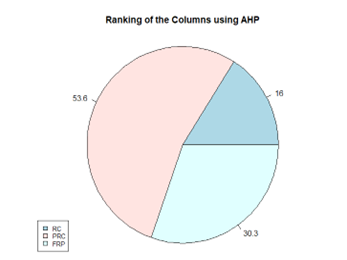By- |Anurag Mehta | TUB-ID: 0508000 |
- Introduction :
As the modern construction industry evolves, the need of sustainable buildings and materials becomes increasingly crucial. As engineers and architects are moving to the designs that are not only durable but also environmental friendly. Columns are critical structural components in the buildings , plays a significant role in defining the environmental impact, lifecycle cost and overall efficiency of the building. Selecting the best material and design of the column is a complex decision that involves balancing structural integrity, economic considerations and the main thing is environmental impact.
This assignment report focuses on the conducting a comprehensive Life Cycle Assessment (LCA) for finding the best of three different column designs for a residential building. The study aims to analyse the lifecycle impacts by energy usage, emission of gases (CO2, NOx, SO2) by the three columns over a 100-year period encompassing material extraction, manufacturing, transportation, construction, maintenance interventions, and end-of-life scenarios. Additionally a Multi-Criteria Decision Analysis (MCDA) is employed to rank the alternatives based on key performance criteria.
- Design Options :
Three design options for the columns are selected.
1.Reinforced Concrete – RC column(Cast in place). 2. Precast Concrete (PRC) Column 3. Fiber-Reinforced Polymer (FRP) column.
xxxxxxxxxx
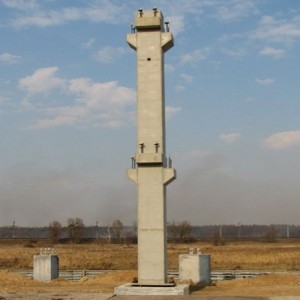

-
Lifecycle Timespan and Timeline :
We considered three events that happens to the column usually.
- Minor Repairs (MR): Regular inspections and minor maintenance task such as patching cracks or reapplying the protective coatings.
- Major Repairs (MJR) : Replacing/repairing damage sections other major problems and addressing reinforcement corrosion.
- Retrofitting (RF) : Structural upgrades such as adding additional support, reinforcement to the column or FRP wraps/patches to extend lifespan or improve load capacity.
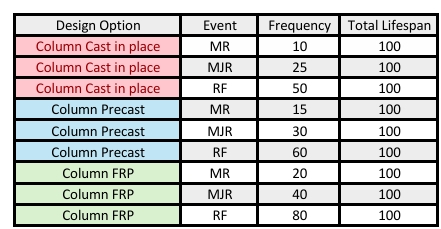
Table-1.
-
Life Cycle Inventory :
LCI data for the materials used in the column design (Marceau,2007). The units of energy consumption and emission of gasses are(MJ/t), CO2, NOx, SO2 (kg/m3). The quantities of materials consumed to produce a cubic meter of concrete.
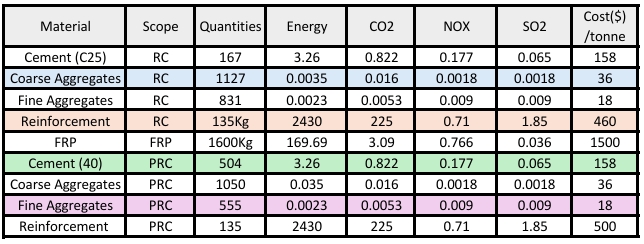
Table 2.
FRP: Density of fibre Reinforced polymer is 1600kg/m3 (FRP properties), so for 1m3 1600kg of FRP is needed.
Reference for the cost chosen for the materials given at the last in reference section.
Assumption : Columns made completely of fibre-Reinforced polymer(FRP) are not common in practice. They are usually combined with a core material ( like Reinforcement in concrete columns) to achieve sufficient load-bearing capacity. But we do not have much data about it for the reference. Also we do not have load data that is coming on the columns. So we are assuming the same volumes for every design option so that we can compare them on the basis of size of the columns. -
Life Cycle Analysis for our Columns :
Life Cycle Analysis (LCA) evaluates environmental impacts of the material used throughout its whole lifecycle- from raw material extraction to the end of the life of that material. We will be able compare the environmental performance , sustainability and costs.
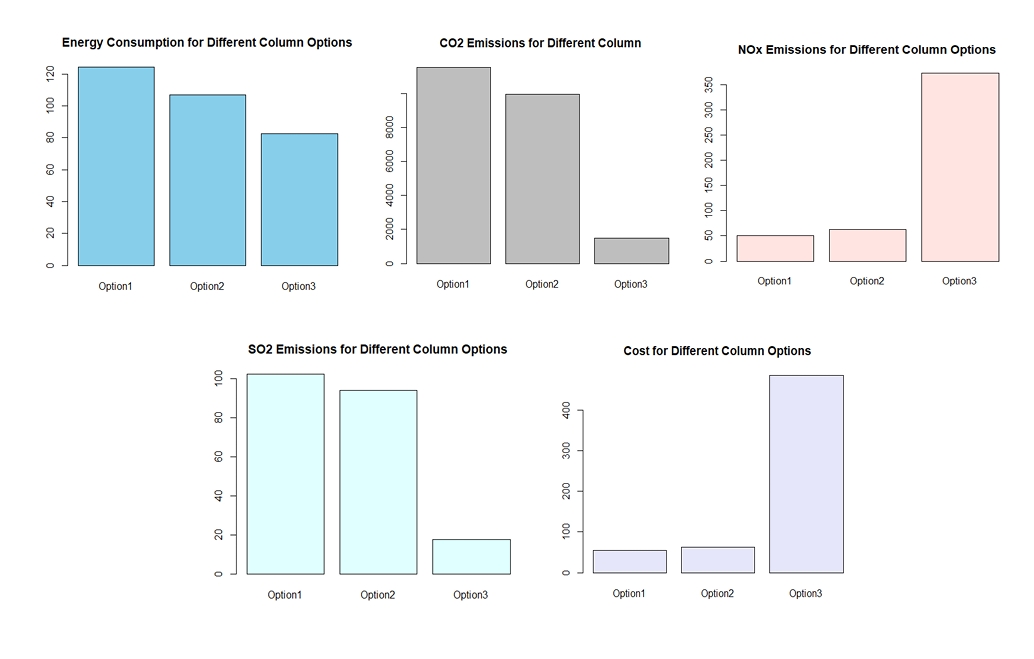
Key Observations :
- FRP requires the least energy (82.47 MJ), followed by PRC (106.83 MJ) and RC (124.21 MJ).
- FRP has significantly lower CO2 emissions (1501.74 Kg) compared to RC (11542.12 kg) and PRC (9982.13 kg).
- FRP has the highest NOx emissions (335.232 Kg) while RC has the lowest (50.99 Kg).
- FRP produces the least SO2 (17.50 kg), with RC being the highest (102.10 Kg).
- FRP is the most expensive option (729.00 $), while RC (57.77 $) and PRC (77.73 $) are more economical.
Discussion :
- Let’s discuss the result we got by the visual plot after running the code in RStudio. The substantially lower energy consumption of FRP is noteworthy. This reduction can be attributed to the lightweight nature and lower embodied energy of FRP compared to the conventional concrete materials. This makes FRP a highly energy-efficient choice but not in NOx, especially for applications where sustainability is a priority.
FRP also exhibits lowest value of CO2 emissions. This is largely because due to lower volume of material required and the inherently lower carbon footprint of FRP manufacturing process.
FRP has markedly higher NOx emissions that both RC and PRC, And at last, As we all know Sustainability comes with a cost ,and this is we can see in the plot that FRP is the most expensive option among all three options.
x
x
-
Multi-Criteria Decision Analysis:
( Analytic Hierarchy Process): The process involves pairwise comparisons of alternatives and criteria to determine a ranking based on the weighted values.So to compare the criteria , we use expert advices and Saaty’s Scale (1-9) – ( Saaty, 1980 ) to the quantify the relative importance of each criterion. We have to create matrix for pairwise comparison and then look for the weight of each matix. The final ranking are calculated as a weighted sum of all alternatives weights for every criteria. After writing and running the code for AHP , all the calculation is done by the codes based on the values we decide from Saaty’s scale for the comparison.
Discussion : PRC rank the first based on the criteria that are Energy, Co2, NOx, SO2 and cost. FRP rank second and then followed by RC column. That means according to the calculation we have done in AHP process PRC column is the best choice to build a column when we have these criteria’s.
Trade-offs and Engineering Rationale : The selection of the optimal column type involves balancing cost, durability and environmental impact :
1). Cost vs. Sustainability: FRP have higher initial cost to construct but RC and PRC have low initial cost. FRP also have higher sustainability it can be used in the projects where we have high initial budget. For budget sensitive projects RC and PRC option is the most viable.
2). Durability vs Maintenance : All option are durable but if we look at maintenance, FRP requires Less frequent maintenance then RC and PRC. We can solve this issue by prioritizing FRP column in corrosive environments as RC and PRC steel is suspectable to corrosion.
3). Environmental Impact vs. Industry Adoption : For innovative projects where environmental performance is highly important FRP
can be adopted. And RC and PRC column is best suited for conventional projects.
xx
x
x
x
- References :
- [1]. Marceau, M., Nisbet, M.A. and Van Geem, M.G., 2007. Life cycle inventory of portland cement concrete. Portland Cement Association. http://www.nrmca.org/taskforce/item_2_talkingpoints/sustainability/sustainability/ sn3011%5B1%5D.pdf
- [2]. Saaty, 1980- Saaty’s 1-9 scale pairwise comparison :https://www.researchgate.net/figure/SAATYS-1-9-SCALE-OF-PAIRWISE-COMPARISONS_tbl1_285828294
- [3]. FRP properties : Technical and mechanical properties of fiber-reinforced polymer (FRP) system.https://www.researchgate.net/figure/Technical-and-mechanical-properties-of-carbon-fiber-reinforced-polymer-CFRP-system_tbl2_338514412
- [4]. Cost of cement : https://www.ibisworld.com/us/bed/price-of-cement/190/
- [5].Cost of coarse aggregate : https://www.cardigansand.co.uk/collections/construction-coarse-aggregates
- [6]. Cost of fine aggregate : https://aggregatemarkets.com/price-list?srsltid=AfmBOooqQWW6Gb6OOjry8-N9vk_cK2sp94Pjv-nQcYZdqgMfHGlmBdGP
- [7]. Cost of Reinforcement : https://www.dailymetalprice.com/metalprices.php?c=st&u=mt&d=20
| Main Page | Introduction | Individual Systems | Integration Context | Integrated Maintenance Strategies | Life Cycle Analysis | Multi-Objective Optimization |
